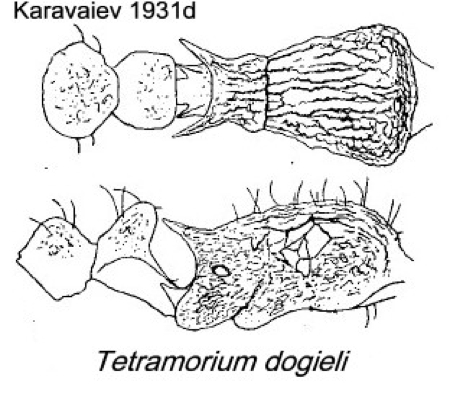Tetramorium dogieli Karavaiev
  Type location Kenya
(Karavaiev, 1931d: 48, illustrated, worker) - no images on Antweb (April 2015) Type location Kenya
(Karavaiev, 1931d: 48, illustrated, worker) - no images on Antweb (April 2015)
worker only described (see
Bolton, 1995)  . .
|
 Karavaiev's (1931d) description is at Karavaiev's (1931d) description is at  . Bolton's note, which has no description,
(1980) is at . Bolton's note, which has no description,
(1980) is at  . Bolton's (1980) diagnosis, extracted from
his key, is at . Bolton's (1980) diagnosis, extracted from
his key, is at  . .
WORKER - TL 2.5 mm.
Type collection from Naivasha, by Dogiel & Sokolov.
Karavaiev's description draws similarities with Tetramorium
squaminode. The Bolton key separation (couplet 51) has
"mandibles closely and coarsely longitudinally striate" but Karavaiev
has "Mandiblen fein längsgestricheit", i.e. fine longitudinal
striation. He also noted the colour as yellowish brown with the
antenna, mandibles, legs, spines and underside of the gaster
lighter.Karavaiev also has the petiole and postpetiole as "glatt und
glänzend", i.e. smooth and shiny. which appears to contradict the weak
patterns on his drawing.
|
Oxford University Museum
specimens
Tetramorium dogieli
B Taylor det.
|
Tanzania
V Grebennikov
|
09-11.x.2002
Usambara Mts
5°05' S
38°38' E
|
Amani NR, Zigi Lodge, 2200 m
|
2
|
 |
|
 The
photomontage is of two specimens collected from the Usambara Mts, Tanzania;
Zigi Lodge, Amani NR; collector Vasily Grebennikov. The
photomontage is of two specimens collected from the Usambara Mts, Tanzania;
Zigi Lodge, Amani NR; collector Vasily Grebennikov.
Worker: TL ca 2.5 mm, HL 0.62, HW 0.5, CI = 0.81, SL 0.42,
SI = 84, PW 0.42. These specimens appear to match Karavaiev's
description and drawings, although the petiole node is more nodiform
than it is squamiform. With more lateral illumination, however, the
petiole does appear angular. The weak patterning on the petiole and
postpetiole also can be seen. The mandibles are paler and almost
smooth.
|
|